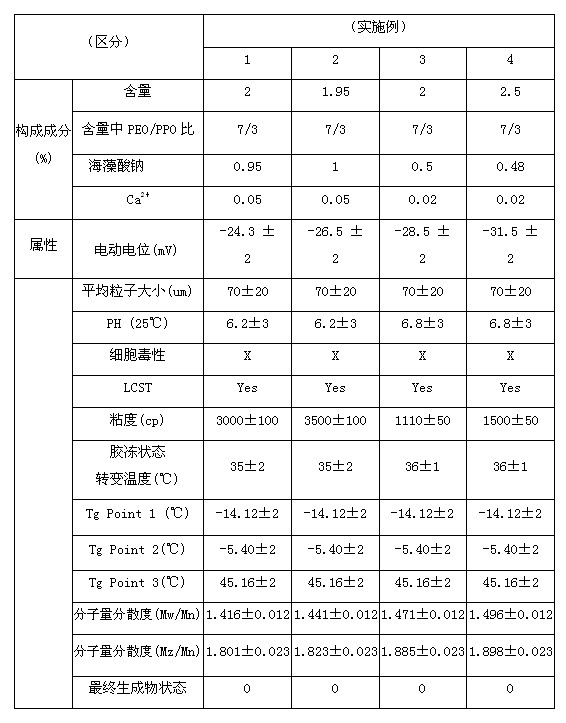Polylactic acid-glycolic acid copolymer particle bracket for injection and manufacturing method thereof
A glycolic acid copolymer, glycolic acid technology, applied in medical science, prosthesis, surgery, etc., can solve the problems of flow in the injection site, non-biodegradability, and inability to apply to plastic parts, and achieve the effect of promoting adhesion
- Summary
- Abstract
- Description
- Claims
- Application Information
AI Technical Summary
Problems solved by technology
Method used
Image
Examples
Embodiment 1
[0040] The polylactic acid-glycolic acid copolymer particle scaffold for injection is mainly composed of the following components in weight ratio: matrix 0.8, temperature-sensitive auxiliary agent 3, wherein the matrix is a biodegradable polymer composed of polylactic acid-glycolic acid PLGA, a temperature-sensitive auxiliary agent, consists of the following components by weight ratio: polyoxyethylene and polyoxypropylene triblock copolymer 2, non-toxic degradable sodium alginate-based biocompatible high molecular polymer 0.95, Ca 2+ Ion 0.05, Polyoxyethylene and Polyoxypropylene Triblock Copolymer Composed of Polyoxyethylene and Polyoxypropylene Triblock Copolymer in a ratio of Polyoxyethylene to 70% Polymer and Polyoxyethylene and Polyoxypropylene Triblock Copolymer The ratio of polyoxyethylene in the block copolymer was 80% of the polymer composition. The particle average molecular weight of the biodegradable particle scaffold is 90,000-110,000, and the average particle ...
Embodiment 2
[0055] Polylactic acid-glycolic acid copolymer particle scaffold for injection, which is mainly composed of the following components in weight ratio: matrix 1, temperature-sensitive auxiliary agent 3, wherein the matrix is a biodegradable polylactic acid-glycolic acid composed of Polymer PLGA, the temperature-sensitive auxiliary agent consists of the following components by weight ratio: polyoxyethylene and polyoxypropylene triblock copolymer 2.5, non-toxic degradable sodium alginate-based biocompatible polymer polymer 0.48, Ca 2+ Ionic 0.02, Polyoxyethylene and Polyoxypropylene Triblock Copolymer Composed of Polyoxyethylene and Polyoxypropylene Triblock Copolymer with a Polyoxyethylene ratio of 70% Polymer and Polyoxyethylene and Polyoxypropylene Triblock Copolymer The ratio of polyoxyethylene in the block copolymer was 80% of the polymer composition. The particle average molecular weight of the biodegradable granular scaffold is 90,000-110,000, and the average particle si...
Embodiment 3
[0070] Polylactic acid-glycolic acid copolymer particle scaffold for injection, which is mainly composed of biodegradable polymers, wherein the biodegradable polymers include components in weight ratio: matrix 0.9, temperature-sensitive auxiliary agent 3, wherein , the matrix is a biodegradable polymer PLGA composed of polylactic acid-glycolic acid, and the temperature-sensitive auxiliary agent includes components in the following weight ratio: polyoxyethylene and polyoxypropylene triblock copolymer 1.95, non-toxic Degradability of alginate-based biocompatible polymer 1.0, Ca 2+ Ion 0.05, Polyoxyethylene and Polyoxypropylene Triblock Copolymer Composed of Polyoxyethylene and Polyoxypropylene Triblock Copolymer in a ratio of Polyoxyethylene to 70% Polymer and Polyoxyethylene and Polyoxypropylene Triblock Copolymer The ratio of polyoxyethylene in the block copolymer was 80% of the polymer composition. The particle average molecular weight (Mw) of the biodegradable granular sc...
PUM
| Property | Measurement | Unit |
|---|---|---|
| Particle size | aaaaa | aaaaa |
| Average particle size | aaaaa | aaaaa |
| Size | aaaaa | aaaaa |
Abstract
Description
Claims
Application Information
 Login to View More
Login to View More - R&D Engineer
- R&D Manager
- IP Professional
- Industry Leading Data Capabilities
- Powerful AI technology
- Patent DNA Extraction
Browse by: Latest US Patents, China's latest patents, Technical Efficacy Thesaurus, Application Domain, Technology Topic, Popular Technical Reports.
© 2024 PatSnap. All rights reserved.Legal|Privacy policy|Modern Slavery Act Transparency Statement|Sitemap|About US| Contact US: help@patsnap.com










